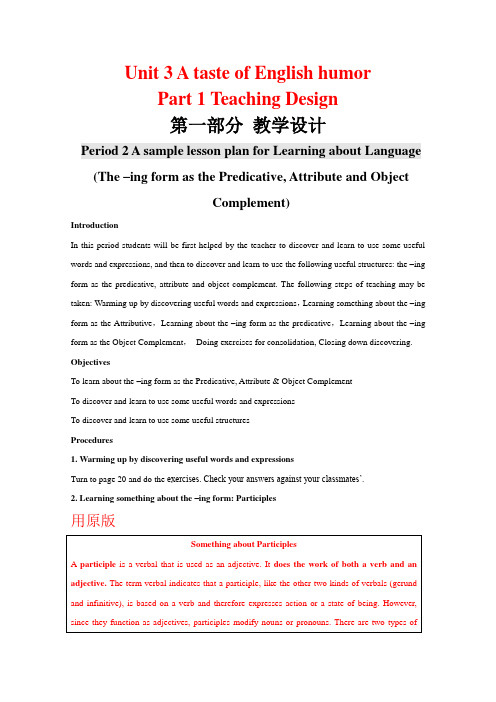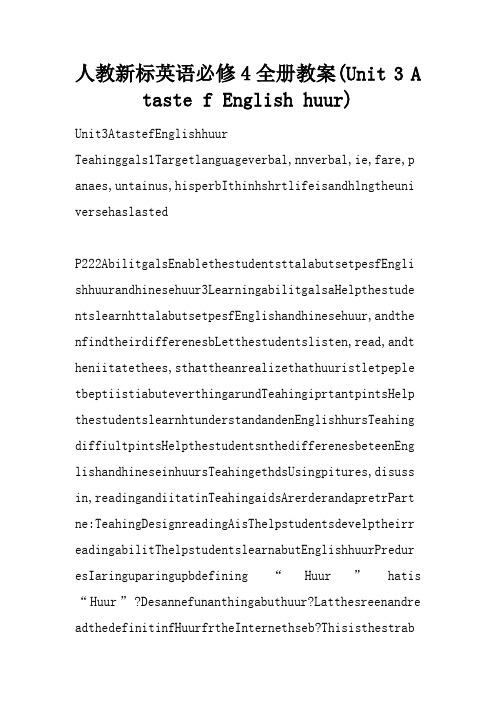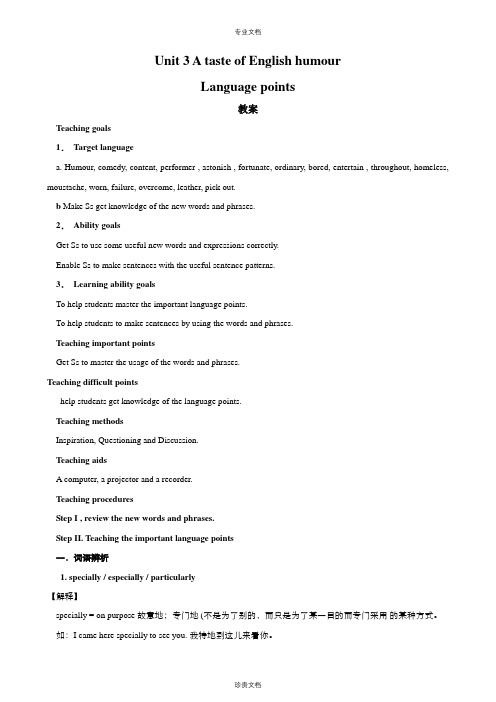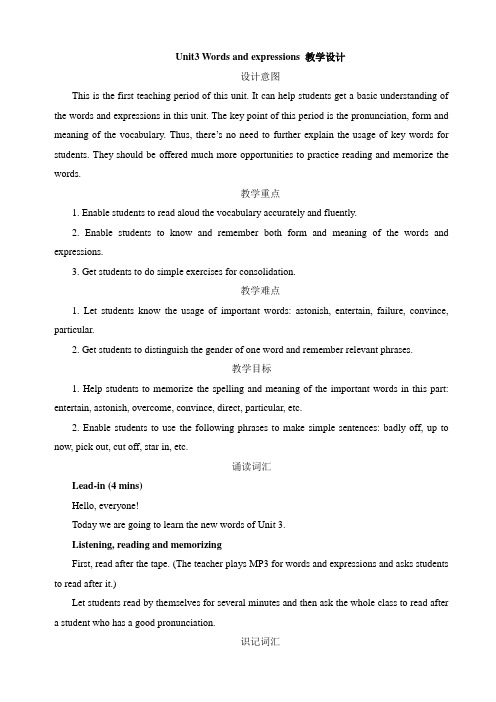英语必修四人教版必修4+unit3+Writing教案
- 格式:docx
- 大小:13.87 KB
- 文档页数:2

O2U3 Food and Culture 教学设计(一)教学背景概要性写作是高考写作题型的一种。
概要性写作在高考中出现的频率不如读后续写高,因此受到教师和学生的重视不足,学生在概要性写作时的表现往往不如读后续写,对于概要性写作的结构、功能句式以及句子转写技巧不熟悉。
部分教师在教学时,不能引导学生对文本进行分析从而梳理写作思路,只依照答案范文为学生进行分析,灌输应试技巧,造成了学生语言输入不足,写作框架缺失,写作思维匮乏的现象。
如何通过对文本的分析和梳理习得概要性写作中的结构框架、功能句型和写作技巧,从而实现写作产出与原文之间的语句通顺、逻辑相通,成为不少教师的困惑。
鉴于此,本课例使用高中英语“三段七步”读思写整合教学模式,以教材文本为例,探讨新教材背景下,高中英语概要性写作如何实现写前结构、语言、技巧等支架的搭建,从而如何实现阅读与写作的目标一致。
(二)教学分析1、教学内容分析本课教学内容选自2020人教版普通高中英语教材选修二第三单元Food and Culture的Using Language板块。
本单元阅读文本的主题是饮食和文化,主题语境为人与社会。
该语篇是一篇议论文,以健康饮食为主题,解读了什么是健康饮食、怎样进行健康饮食,旨在让学生了解健康的饮食方式。
正文内容遵循“总-分-总”的结构。
第一段为总起段。
第二段至第四段,作者列举了三种健康饮食的方法,并通过引用、列数据等方法使自己的论证更加具有信服力。
在上述列举的基础上,作者在最后一段进一步对健康饮食的核心进行了解读,对文章进行了总结。
就文体特征来看,该文本论述主题和论述过程准确、鲜明、严密、有针对性,按照总-分-总的方式开展议论,段落与段落之间有着较清楚的逻辑关系,每个段落内也存在清晰的结构关系。
该文本中的第二段到第四段按照逻辑顺序,围绕文章的中心,列举了三种健康饮食的方式,是一篇适宜进行概要性写作的文本;就语言来看,该文本使用了起过渡性作用的语句或关联词,如“however” “beyond this” “finally” “in other words”等,为学生在写前环节进行衔接手段的学习提供了语言支撑;就内容来看,文章话题为健康饮食,属于常见的话题,在内容上贴近学生生活,方便学生阅读和理解。

Unit 3 A taste of English humorPart 1 Teaching Design第一部分教学设计Period 2 A sample lesson plan for Learning about Language (The –ing form as the Predicative, Attribute and ObjectComplement)IntroductionIn this period students will be first helped by the teacher to discover and learn to use some useful words and expressions, and then to discover and learn to use the following useful structures: the –ing form as the predicative, attribute and object complement. The following steps of teaching may be taken: Warming up by discovering useful words and expressions,Learning something about the –ing form as the Attributive,Learning about the –ing form as the predicative,Learning about the –ing form as the Object Complement,Doing exercises for consolidation, Closing down discovering. ObjectivesTo learn about the –ing form as the Predicative, Attribute & Object ComplementTo discover and learn to use some useful words and expressionsTo discover and learn to use some useful structuresProcedures1. Warming up by discovering useful words and expressionsTurn to page 20 and do the exercises. Check your answers against your classmates’.2. Learning something about the –ing form: Participles用原版Find the participial phrases in these sentences and tell what word they modify.1. The man running slowly still finished the race.2. The boy having been scolded finally did his work.3. The teacher, having retired, could now travel widely.4. The soldier, having saluted his superior, continued on his way.5. The truck swerving and sliding hit the brick wall.Keys:1. running slowly modifies man2. having been scolded modifies boy3. having retired modifies teacher4. having saluted his superior modifies soldier5. swerving and sliding modifies truck3. Doing exercises for consolidation4. Closing down by discoveringTo end the period you are going to skim the text and the previous texts to find out all the examples containing –ing forms used as the predicative, attributive and object.Unit 3 A taste of English humorPart 1 Teaching Design第一部分教学设计Period 3 A sample lesson plan for Using Language(English jokes)IntroductionLanguage is learned to be used in and for communication. So in this period we shall have the students read, listen, write and speak in English, making use of the focused words, expressions, structures and topic ideas covered in this unit. Warming up by reading school jokes comes first to be followed by reading and underlining and doing the exercises. Guided speaking and writing will lead to the end of the period: closing down by acting.ObjectivesTo enjoy reading the paragraph of Jokes about Sherlock Holmes and Doctor WatsonTo learn to use the language by reading, listening, speaking and writingProcedures1. Warming upWarming up by reading school jokesThere are lots of jokes in English about school life. Read one to see whether you will laugh or not. 用原版2. Reading and underliningRead the paragraph and underline all the useful expressions or collocations in it. Copy them into your notebook after class as homework.3. Doing the exerciseNow you are going to do the exercise 1 on page 22.4. Guided SpeakingThink of funny stories in English and tell them to your group mates.5. Guided Writing—Learn to write jokesThere are two main parts to the structure of a joke. The first part prepares you for the laugh by telling a story which creates a sense of expectation. The second part of the joke, the punch line, provokes laughter by telling an unexpected and different story, yet one which is still compatible with the first, as in this example: “My wife just ran off with my best friend. Boy, do I miss him.” and “I had a mud pack facial done, and for three days my face loo ked much better. Then the mud fell off.” Notice the assumption that is made in both these examples. In the first, you assume the person telling the story is angry with his wife, so the punch line surprises you because he's feeling something different and unexpected. Again, in the second example, you'd most likely assume the mud had been removed, leaving the face looking better, so the punch line takes you by surprise.So, to write jokes you need to practice reading statements and writing down the assumptions you make about them. You must be able to interpret the statement (first story line) in at least two different ways in order to provide the second, different story i.e. the punch line. And what to write about? Anything that interests you. Anything you have strong opinions about.Now write down your own jokes, in English.6. Closing down by actingActing out the text is a strategy for motivating us to read out loud the text. We need oral practice and help with pronunciation and so acting out the text really helps us.To end this period, we are going to act the film by Charlie Chaplin, The Great Dictator.。

人教新标英语必修4全册教案(Unit 3 A taste f English huur)Unit3AtastefEnglishhuurTeahinggals1Targetlanguageverbal,nnverbal,ie,fare,p anaes,untainus,hisperbIthinhshrtlifeisandhlngtheuni versehaslastedP222AbilitgalsEnablethestudentsttalabutsetpesfEngli shhuurandhinesehuur3LearningabilitgalsaHelpthestude ntslearnhttalabutsetpesfEnglishandhinesehuur,andthe nfindtheirdifferenesbLetthestudentslisten,read,andt heniitatethees,sthattheanrealizethathuuristletpeple tbeptiistiabuteverthingarundTeahingiprtantpintsHelp thestudentslearnhtunderstandandenEnglishhursTeahing diffiultpintsHelpthestudentsnthedifferenesbeteenEng lishandhineseinhuursTeahingethdsUsingpitures,disuss in,readingandiitatinTeahingaidsArerderandapretrPart ne:TeahingDesignreadingAisThelpstudentsdevelptheirr eadingabilitThelpstudentslearnabutEnglishhuurPredur esIaringuparingupbdefining“Huur”hatis “Huur”?Desannefunanthingabuthuur?Latthesreenandre adthedefinitinfHuurfrtheInternethseb?ThisisthestrabutfurpeplenaedEverbd,Sebd,AnbdandNbdThereasaniprtantbtbedne,andEverbdassurethatSebduldditAnbduldhavedneit,butNbddiditSebdgtangrabutthatbeauseitasEverbd&aute;sbEverbdthughtAnbdulddit,butNbdrealisedthatEverbduldn&aute;tditItendedupthatEverbdblaedSebdhenNbddidhatAnbduldhavedneIIPre-readingTellingthetr uth—hdulietlaughat?Ilietlaughatartns,frthe’relvelandfunIlietlaughatfairtalesTheareausingandint erestinganearsagtherelivedanEperrhassexeedinglfndff inenelthesthathespentvastsusfnendressThiltheseantre thananthingelseintherldHetninterestinhisar,nrdidhea retgtthetheatre,rtdriveabutinhisstateah,unlessitast displahisnelthesHehaddifferentrbesfreversinglehurft hedaIIIReading1ReadingaludtthererdingNpleaselistenandreadaludtthererdingfthetextNNVERBALHUURPaattentinttheprnuniatinf eahrdandthepausesbeteenthethughtgrupsIillplathetape tieandushallreadaludtie,t2ReadingandunderliningNextuaretreadandunderlineallth eusefulexpressinsrllatinsinthepassageptheturntebaft erlassasher3ReadingtidentifthetpisentenefeahparagrapSithetextan didentifthetpisentenefeahparagraphuafinditeitheratt hebeginning,theiddlertheendftheparagraph4ReadingandtransferringinfratinReadthetextagaintplet ethetableNNVERBALHUURhatisnnverbalhuur?hisharliehap lin?Hdesheaeasadsituatinentertaining?hatisthestrfTh eGldRush?FatsabutsarAbrieflifehistrfharliehaplinReadingandunderstandingdiffiultsentenesAsuhavereadt hetextties,uansureltellhihsentenesarediffiulttunder standNputurquestinsnerningthediffiultpintstetheteah erIVlsingdnlsingdnbdingexerisesTendthelessnuaretdth eprehendingexerisesN1and2npages18and19lsingdnbathingasilentviebharliehaplinDulieathingvies?Duliehuurus vies?Nlet’sathasilenthuurusviebharliehaplinIt’sharliehaplin'sfirstfil:aingaLivinglsingdnbreadinga butharliehaplinTendtheperideshallreadanartileabutha rliehaplinNlatthesreenandreaditaluditheThesendperid LearningabutLanguageAisThelpstudentslearnabutThe–ingfrasthePrediative,Attributive≈bet)Thelpstuden tsdisverandlearntuseseusefulrdsandexpressinsThelpst udentsdisverandlearntuseseusefulstruturesPreduresIa ringuparingupbdisveringusefulrdsandexpressinsTurntp age19anddexerisesN1,2,3,4andheuransersagainsturlass ates’IILearningabutThe–ingfrastheAttributivehatisattributive?Itissethingpl aedbefrethenunstbedified:“red”isanattributiveadetivein“aredapple”“aling”isalsanattributiveadetivein“aalingsti”IIIReadusedaterialsfrThe–ingfrasthePrediative,Attributive≈bethihverbsanbe flledbthe-ingfr?IVlsingdnlsingdnbdisveringTendthepe riduaregingtsithetextandthepreviustextstfindutallth eexaplesntaining–ingfrsusedastheprediative,attributiveandbetlsingdnbexerisesInthelastfeinutesuaretdexerises1,2,3and4npa ge21heuransersagainstthsefurgrupates’ThethirdperidUsingLanguageAisThelpstudentsreadthepa ragraphfesabutSherlHlesandDtratsnThelpstudentstuset helanguagebreading,listening,speaingandritingPredur esIaringuparingupbreadingshlesThereareltsfesinEngli shabutshllifeReadthesettseehetheruilllaughrnthustel earnthis?为什么要学这个呀?nedaurprfessrasdisussingapartiularlpliatedneptApre-edstudentrudelinterruptedtas,"hdehavetlearnthispint lessinfratin""Tsavelives"theprfessrrespndedquilandntinuedtheletu reAfeinuteslater,thesaestudentspeupagain"Shdesphsissa velives?"hepersisted"Iteepstheignrauseslieuutfedialshl,"repliedtheprfes srIIGuidedreading1.ReadingandtranslatingReadtheparagraphnpage22andtranslateitinthinesesentenebsentene2ReadingandunderliningNextuaretreadtheparagphandunde rlinealltheusefulexpressinsrllatinsinitptheturnteba fterlassasherllatinsfrtheparagraphnpage22Gap,inaunt ainusarea,lieinthepenair,underthestars,lupatthestar s,thinf…,trathirdtie,inne’sbeds3DingtheexeriseNuaregingtdtheexeriseN1npage22IIIGuid edSpeaingThinffunnstriesinEnglishandtellltheturgrup atesIVGuidedriting—LearntriteesTherearetainpartstthestruturefaeThefirs tpreparesufrthelaughbtellingastrhihreatesasensefexp etatinThesendpartfthee,thepunhline,prveslaughterbte llinganunexpetedanddifferentstr,etnehihisstillpatib leiththefirst,asinthisexaple:"ifeustranffithbestfri endB,dIisshi"and"Ihadaudpafaialdne,andfrthreedasfae leduhbetterThentheudfellff"Ntietheassuptinthatisade inbththeseexaplesInthefirst,uassuethepersntellingth estrisangrithhisife,sthepunhlinesurprisesubeausehe' sfeelingsethingdifferentandunexpetedAgain,inthesend exaple,u'dstlielassuetheudhadbeenreved,leavingthefaelingbetter,sthepunhlinetaesubsurpriseS,triteesunee dtpratiereadingstateentsandritingdntheasuptinsuaeab uttheuustbeabletinterpretthestateentinatleasttdiffe rentasinrdertprvidethesend,differentstriethepunhlin eAndhattriteabut?AnthingthatinterestsuAnthinguhaves trngpininsabutNritednurnes,inEnglishIVlsingdnbating Tendthisperid,earegingtatthefilbharliehaplinTheGrea tDitatrPartTTeahingResures1.AtextstrutureanalsisfN NVERBALHUURITpefritingandsuarftheideaTpefritingThis isapieefdesribtiveritingainideafthepassageharliehap linastnishesusiththedeepfeelingsheaninspireinusfrah araterheisplaingTpisentenef1stparagraphSehuuranberu elTpisentenef2ndparagraphharliehaplinissuhanatrasta stnishusiththedeepfeelingsTpisentenef3rdparagraphHd idharliehaplinaeasadsituatinentertaining?Tpisentene f4thparagraphThefilfTheGldRushissetinalifrniaTpisen tenefthparagraphharliehaplinprdued,direted,andrteth evieshestarredinIIAtreediagrafthetextharliehaplin—TheGldRushharliehaplinaingasadsituatinentertaining? ThefilfTheGldRushsetinalifrniaheregldasdisveredHuursbeingruelharliehaplinastnishi ngusiththedeepfeelingsharliehaplinprduing,direting, andritingthevieshestarredinIIIAretldpassagefthetext GiveApssibleversin:ThefurthperidListeningStep1ListeningnP23Listentthetapeandanserth efllingquestins1hihisbesttitlefrthisstr?2hasarSithf rustrated?3hatturnedtheaintine?4Didufindthisstrfunn ?h?hatduthinfhn’sbehavir?Step2ListeningtextHandutthelisteningateria landlistentthetape,thenpletethepassageStep3Listenin gnP1Listentthetapeandtitherdsuhear2Listentthetapeag ainandanserthefllingquestins1)heredidPetergetthepta tes?2)hdidn’tPeteranttgetuphenthethiefasinhishuse?3huldn’tthethieftaeaatheptates?4HdidPeterstptheanstealingt heptates?Step4ListeningtextListentthetapeandpletethelistenin gtextThenassestudentstreadthepassageiththerightanse rs,andtelltheainideaStepListeningtasnP81Listentthet apeandhsethebestpiturethatbestdesribeshathappened2hsethebestanserteahquestin3Listentthetapeagainandans erthequestinHduthintheteaherfelthenheasfferedthedg? Step6DisussinDisusshuuldslvetheseprblesandhelpthete aherStep7HerPleaselletasanfunnstriesasuanTheillbeus efulinthenextperidAndtrtfindseinterestingrdsinthese striesThefifthperidSpeaingandritingStep1aringupLattheflli ngpituresabuthuurThenas:Hanindsfhuurdun?Step2EnaedL istentthetapeandfinishthefllingfrBrnDiedbAtingtpeas terpieesStep3therexaplesfEnglishhur1ieandfare rBean2funnstriesarTain:LifentheississippiAdventuresfHuleberrFinnAdventuresfTSaerExaplesfhinesehuurfunnplasStep41Rea dseftheseusterandaiteresandaththeeiththeexplanatinn P222ShreesStepHerPrevietheReadingaterialandfinishth eprehendingahead。

Unit 3 A taste of English humourLanguage points教案Teaching goals1.Target languagea. Humour, comedy, content, performer , astonish , fortunate, ordinary, bored, entertain , throughout, homeless, moustache, worn, failure, overcome, leather, pick out.b Make Ss get knowledge of the new words and phrases.2.Ability goalsGet Ss to use some useful new words and expressions correctly.Enable Ss to make sentences with the useful sentence patterns.3.Learning ability goalsTo help students master the important language points.To help students to make sentences by using the words and phrases.Teaching important pointsGet Ss to master the usage of the words and phrases.Teaching difficult pointshelp students get knowledge of the language points.Teaching methodsInspiration, Questioning and Discussion.Teaching aidsA computer, a projector and a recorder.Teaching proceduresStep I , review the new words and phrases.Step II. Teaching the important language points一.词语辨析1. specially / especially / particularly【解释】specially = on purpose故意地;专门地 (不是为了别的,而只是为了某一目的而专门采用的某种方式。

人教新目标高中英语必修四Unit3单元教学设计人教新目标高中英语必修Unit3教学准备1. 教学目标(一)【知识与能力】知识目标:了解非语言形式的幽默艺术。
了解卓别林的生平以及他在无声电影中的精湛表演。
帮助学生习得并掌握本文出现的词汇、语言表达方式,同时欣赏文章中的优美句式。
能力目标:帮助学生进一步提高阅读中猜词义、略读、查读、跳读、归纳、总结等能力。
引导学生进一步了解与体会V-ing形式在文中的呈现。
(二)【过程与方法目标】1.通过限时阅读、速读等阅读方法逐步提高学生的阅读技巧。
2.课堂活动的设计体现循序渐进,引导学生自主探究地学习与互动,帮助学生打开思维空间。
(三)【情感态度与价值观目标】1.通过对幽默的了解以及对卓别林的走近,鼓励学生保持乐观的人生态度,培养幽默感,陶冶情操。
2.欣赏文中的优美句子,激发学生的语言学习兴趣与热情。
2. 教学重点/难点重点:1.如何在有限的时间内引导学生参与课堂活动,最大限度地激发学习兴趣。
2.各种阅读技巧的交错使用以帮助学生稳步提高阅读能力。
难点:1.引导学生如何正确捕捉信息,归纳总结段落及全文大意。
2.培养学生对文章整体结构的把握和分析人物个性,学会学后简介人物。
3. 教学用具4. 标签教学过程Step1: Lead in 2′利用问题为课文讲述埋下伏笔,用卓别林的图片进行导入,并用brainstorming方式发散学生思维,围绕与幽默相关的词汇展开,卓别林正是由于这些与众不同的因素获得成功,从而成功导入本课主题——卓别林。
【设计意图】利用查理卓别林的生活照和剧照以及头脑风暴的方式既活跃了课堂气氛,又激发了学生用英语表达的欲望,达到寓教于乐的目的,同时也为下一步阅读课文做好铺垫。
读中阶段,既是阅读课文教学的主要环节,又是学生阅读实践的重点内容,这部分教学中将着重训练学生的阅读技巧和策略。
包括:速读(细读和寻读)、细读。
Step2: Fast reading第一环节:skimming (略读) 2′让学生快速阅读课文,并找出文章大意及文章中提及的一部电影。

Unit3 Words and expressions 教学设计设计意图This is the first teaching period of this unit. It can help students get a basic understanding of the words and expressions in this unit. The key point of this period is the pronunciation, form and meaning of the vocabulary. Thus, there’s no need to further explain the usage of key words for students. They should be offered much more opportunities to practice reading and memorize the words.教学重点1. Enable students to read aloud the vocabulary accurately and fluently.2. Enable students to know and remember both form and meaning of the words and expressions.3. Get students to do simple exercises for consolidation.教学难点1. Let students know the usage of important words: astonish, entertain, failure, convince, particular.2. Get students to distinguish the gender of one word and remember relevant phrases.教学目标1. Help students to memorize the spelling and meaning of the important words in this part: entertain, astonish, overcome, convince, direct, particular, etc.2. Enable students to use the following phrases to make simple sentences: badly off, up to now, pick out, cut off, star in, etc.诵读词汇Lead-in (4 mins)Hello, everyone!Today we are going to learn the new words of Unit 3.Listening, reading and memorizingFirst, read after the tape. (The teacher plays MP3 for words and expressions and asks students to read after it.)Let students read by themselves for several minutes and then ask the whole class to read after a student who has a good pronunciation.识记词汇1. Fill in the chart below and note the connection between the nouns, verbs, adjectives and adverbs.Suggested answers:精讲词汇Some of the expressions are of great importance. Let us pay attention to them and make up for the missing parts of the sentences at the same time.1. astonish vt.使惊诧【完成句子】(1)We were _____ that he turned up at the party.我们都很惊奇他会在聚会上出现。
高中英语必修四unit3教案教案主题:高中英语必修四 Unit 3 - Amazing People教学目标:1. 熟悉并掌握本单元的词汇、短语和句型,能够正确运用于写作和口语表达中。
2. 学习了解和欣赏一些杰出人物的事迹,培养学生的人文素养和价值观。
3. 提高学生的阅读理解能力和听说能力。
教学内容:本单元的教学内容包括以下几个方面:1. 词汇:成语和短语,如 inspiring, courage, dedicate oneself to, accomplish, make a difference, etc.2. 阅读:阅读杰出人物的故事和传记,如 Mother Teresa, Stephen Hawking, Thomas Edison, etc.3. 口语表达:学习如何描述和赞美一个杰出人物,如 describe their achievements, their character, their contributions to society, etc.4. 写作:学习如何写一篇关于自己崇拜的杰出人物的文章。
教学过程:1. 导入(5分钟):让学生回顾一下上一课时所学的内容,复习相关的词汇和短语。
2. 阅读和理解(20分钟):教师给学生阅读一篇有关Mother Teresa的文章,并提问学生对她的印象是什么,她的贡献和成就是什么。
然后,教师给学生一些问题和练习,帮助学生理解文章的主要内容和细节。
3. 口语表达(15分钟):教师给学生提供一些描述和赞美一个杰出人物的句子,并让学生用自己的话描述一个杰出人物,然后和同桌分享。
4. 写作(20分钟):教师分发一份关于自己崇拜的杰出人物的写作任务,并给予学生写作指导和范例。
学生可以根据自己的实际情况和兴趣选择一个杰出人物,并写一篇文章来描述他们的成就和贡献。
5. 总结和拓展(10分钟):教师让学生总结一下本课所学的内容和重点,然后给学生一些拓展阅读和写作的练习作为作业。
高中英语必修四unit3教案必修是新课程标准改革中的一个名词,是课程结构调整中的一种课程类型。
和必修相对的是选修。
依据规定必需学的,尤指取得学位或到达毕业要求必需学的必修课必修和选修,这是从课程方案中对课程实施的要求来区分的两种,下面是我为大家整理的高中英语必修四unit3教案5篇,期望大家能有所收获!高中英语必修四unit3教案1教学预备教学目标1. Ss will be able to master the following useful new words and expressions.well,smelly,pond,burst,canal,steam,dirt,injure,brick,dam,useless,steel,sh ock,rescue,quake,electricity,army,shelter,fresh, organize, bury, at an end, dig out, coal mine, in ruins2. Ss will be able to know the basic knowledge about Earthquake教学重难点1. The usages of some words and expressions.2. How to train the students’ reading ability in learning the text.教学工具课件教学过程Step I lead-inLet students see a short video and answer the questions1.What happened in the video Earthquakes2.How do you feel seeing the plots(情节) Students’ discussion. Step II Fast reading1. What is the passage mainly about In Tangshan ,earthquakes happened on July 28th 19762. Skim the text and answer the questionsThe type of writing (写作体裁)Narrative writingTopic sentence of Paragraph 1Sentence 1Topic sentence of Paragraph 2Sentence 2Topic sentence of Paragraph 3Sentence 1Topic sentence of Paragraph 4Sentence 1Step III Detailed readingAsk students to read the text carefully and answer the questionsTask1: What were the nature signs of the coming earthquake(选择)Para 11.Water in well( G )2. Well walls(D )3.Chickens pigs(F ) 4 .Mice (A)5.Fish(E )6. Bright lights( B)7. Water pipes(C )A. Ran out of fieldsB. in the skyC. Cracked and burstD. Deep cracksE. Jumped out of pondsF. Too nervous to eatG. Rose and fell, fell and roseTask 2 Fill in the blanksMain IdeaDetailsDamage caused byearthquakePara 2-3At _____ am, the __________ earthquake of the 20th century began . _______ burst from holes in the ground.Hard hills of the rock became rivers of ____.________ covered the ground like red autumn leaves.Two _______ and most of the bridges fell.The railway tracks were now _________pieces of _______.______ now filled the wells instead of water.Water,food,and ______________ were hard to get.The reconstruction(重建) after the earthquakePara 41. The army _____________2. Workers ____________for survivors.3._____________was taken to the city.Details:1. At 3:42 am, the greatest earthquake of the 20th century began.2. Steam burst from holes in the ground.3. Hard hills of the rock became rivers of dirt.4. Bricks covered the ground like red autumn leaves.5. Two dams and most of the bridges fell.6. The railway tracks were now useless pieces of steel.7. Sand now filled the wells instead of water.8. Water, food, and electricity were hard to get.Step IV consolidation (当堂稳固)Let students fill the blanks according to the passageStrange things were happening in the countryside of northeast Hebei. For three days the water in the village wells kept rising and1_________(fall). Farmers noticed that the well walls had deep cracks 2___________ them. A smelly gas came out of the cracks. In3_________farmyards, the chickens and even the pigs were too nervous 4__________(eat). 5_________(mouse) ran out of the fields looking for places 6________(hide). Fish jumped outOf their bowls and ponds. At about 3 am on July 28,1976, some people saw bright lights 7_________ the sky. The sound of planes could 8________(hear) outside the city of Tangshan even 9_________ no planes were in the sky.In the city, the water pipes in some buildings cracked and burst. But the one million people of the city, ________thought little of these events, were asleep as usual that night.1 falling2 in3 the4 to eat5 mice6 to hide 7in 8 be heard 9when 10 who这局部目的是让同学进一步稳固课文的内容。
Book 4 unit 3 A taste of English humourRevision教学设计一、Teaching aims:e the vocabulary learned fluently;2.write a short passage according to the phrases we learned in this unit;3.develop the spirit to face the difficulty and succeed in our life;二、Important points:1.Important points: use the vocabulary learned fluently;write a short passage according to the phrases we learned in this unit;2.Difficult points: develop the spirit to face the difficulty and succeed in our life.三、Teaching methods:1、教学方法:任务驱动法、小组讨论法。
2、学习方法:自主学习法、合作学习法、探究式学习法。
四、Teaching procedures:Part 1 词汇复习词汇Ⅰ:单词自查自纠1._________adj.满足的,满意的n.满足vt.使满足2.__________adj.平常的,普通的3.__________adj.厌烦的4.__________adj.无家的,无家可归的5.__________vt./vi.战胜,克服6.__________adj.突出的,杰出的,显著的7.__________n.时刻,场合8.__________vt./vi.(使)滑动,(使)滑行n.滑,滑动8.___________n.耳语,低语vt./vi.低语,小声说9.throughout prep.___________adv.____________10.chew vt./vi.__________11.gesture n.__________vi._________12.budget n.__________13.mountainous adj._________14.vast adj._________15.mess n.___________16.drunk adj._________Ⅱ派生单词Ⅲ短语1.直到现在____________2.对……满足____________3.穷的,缺少的__________4.挑出,辨别出___________5.切断,断绝___________6.在……担任主角_________7.…使某人相信____________8.对……感到厌倦_____________9.对……挑剔_______ 10.对……作出反应,回应_________Ⅳ.语境应用1.His______words finally_______me,and I was________that he was innocent.(convince)2.To my_______,he didn’t feel________at the_______news that his brother died at all.(astonish)3._________,when he went aboard to try his_________,he gained great wealth.(fortune)4.The children in the mountain village have no__________,so their teachers often tell_________stories to_________them after class.(entertain)5.After school,she________went off in the_________of the cinema to see the new film__________by the famous_________.(direct)Ⅴ.单句改错1.Up to now,I didn’t worked out the meaning of the world.2.He is content at such a small success.3.The birth rate of the world is astonished.4.Unfortunate,I won’t be able to attend your birthday party.5.Jack’s sister entertained us to her stories and jokes.6. A bad habit is easy to form,but hard overcome.Part 2 Topic writing根据提示利用本单元所学知识完成下面的小作文。